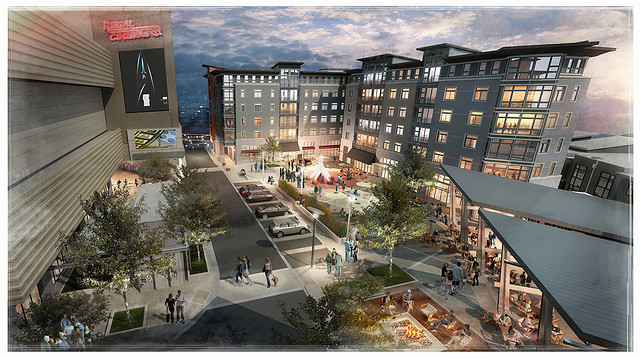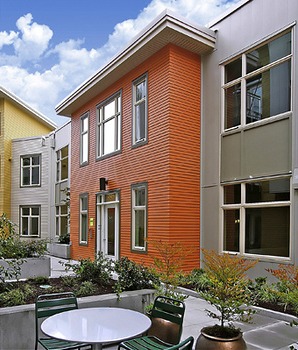Cross-posted from the Natural Resources Defense Council.
Leave it to a city famous for coffee and rain to produce possibly the best example of transit-oriented urbanism, natural public space, and green stormwater infrastructure I have ever seen. This Seattle redevelopment is green in so many ways that it is hard to know where to start.
Maybe we should start with the parking lot, because that’s what the whole nine-acre site was before redevelopment began. Ugly. Horrible for the environment. A complete waste of urban space:
 Before.Photo: Landscape Architecture Foundation
Before.Photo: Landscape Architecture Foundation
The site is in an area that is transitioning from automobile-oriented and suburban in feel to walkable and lively. It sits just south of the Northgate shopping mall, northeast of a community college, a couple of blocks east of the I-5 freeway, and just west of an area of single-family homes. It is transit-rich, however, just a block from a major bus transfer station (with planned light rail access).
Enter the city of Seattle, with a sophisticated initiative to bring long-buried Thornton Creek back to life above the surface, where it belongs. Add lots of carefully planned nature (not really an oxymoron when we’re dealing with a city), arranged to be highly walkable and educational as well as environmentally beneficial. The creek restoration was led under contract to the city by Seattle’s SvR Design, which previously designed the landscape and green infrastructure features of the much-celebrated, mixed-income High Point development, also in Seattle.
Here’s how the Landscape Architecture Foundation (LAF) puts it:
Carved out of an abandoned parking lot, the Thornton Creek Water Quality Channel treats urban stormwater runoff from 680 acres within a necklace of channels, pools, and terraces designed to mimic the performance of a natural creek. Its lush plantings, overlooks, and paths have added 2.7 acres of public open space to the Northgate Urban Center and catalyzed surrounding redevelopment. The facility is a model for how multi-functional landscapes can be integrated into the dense urban fabric.
 After.Photo: Landscape Architecture Foundation
After.Photo: Landscape Architecture Foundation
The redevelopment not only added 530 units of housing (net density: 96 units per acre) and 50,000 square feet of retail space; it simultaneously accomplished the following, according to the LAF:
- Increased open space within the Northgate Urban Center by about 50 percent.
- Provided pedestrian links from adjacent commercial and residential neighborhoods, shortening walking distances by 50 percent.
- Reduced impervious surfaces by 78 percent.
- Designed to remove an estimated 40-80 percent of total suspended solids from 91 percent of the average volume of annual stormwater runoff from the 680-acre drainage basin.
- Created new habitat within this heavily paved commercial area. Within one month after opening, native birds were observed at the project. A variety of desirable native volunteer plants have migrated into the site and begun to establish.
Eighty-five percent of the project’s plant palette are native species, including 172 native trees, 1,792 native shrubs, and 49,000 native perennials, herbs, grasses, rushes, and sedges. The planting mix and the channel’s alignment will be allowed to evolve naturally over time. When was the last time you saw this much additional urban density, increased natural space, and reduced imperviousness on the same site? (For more of the technical details, see the city’s extensive report [PDF] on the project.)
The space also includes some cool public art (by Benson Shaw), along with educational signage about the project’s environmental benefits.
The city is understandably pleased with the results. Note the credit to community involvement:
The [Thornton Creek Water Channel] Facility is designed to remove pollutants from stormwater by slowing urban runoff before these flows enter the creek. The Facility, in conjunction with improvements to surrounding roadways, Northgate Mall, Northgate Library and the Northgate Community Center, is part of a larger strategy to revitalize the Northgate Urban Center. Community involvement was instrumental in making the Facility successful from a number of perspectives. A stakeholder group, made up of a broad balance of community, environmental and business interests, helped drive the Facility’s design, which resulted in a Facility design that integrates environmental and commercial concern … The Facility was constructed by Seattle Public Utilities with funding support from Washington State Department of Ecology via a Washington State Water Pollution Control Revolving Fund Loan.
Nice job.
This leads us to the urbanist part of the redevelopment, which is every bit as impressive as the improvements to public space and water quality. Much of the credit for this accomplishment belongs to a new development called Thornton Place, comprising 109 condos, 278 apartments (20 percent priced below market), a 14-screen cinema, 50,000 square feel of retail, and a very appealing plaza that gives the block a great urban public space in counterpoint to the natural one. Thornton Place was developed by the Swedish-founded Stellar Holdings [PDF].
 Thornton Place.Photo: Thornton Place
Thornton Place.Photo: Thornton Place
According to a story by Eric Pryne in The Seattle Times, Stellar actually offered prospective condo buyers a “layoff-protection plan in hopes of spurring sales in this sour market.” Reflecting the anxiety of current circumstances, the developers agreed to make mortgage payments for up to six months if a condo buyer loses his or her job within the first year.
Writing in the tastefully titled blog hugeasscity, Dan Bertolet says that Thornton Place is really Seattle’s first transit-oriented development, and that the developer deserves credit for taking some risks:
Northgate has been targeted for growth by city planners for decades: It is a designated Urban Center, a bus transit hub and future light rail station area. But the existing car-oriented, single-use built environment around the mall is a highly unappealing site for small-scale mixed-used residential development — what developer would risk being the lonely pioneer amidst a sea of big box and parking lots? In contrast, a large project like Thornton Place creates a center of gravity powerful enough both to keep itself alive, and to be a catalyst for future adjacent development.
Bertolet writes (and I agree) that the walkability of the project would have been even better if it had been broken up into two blocks with a through street in the center, taking advantage of an opportunity to restore lost street connectivity. That would have required some serious design thought to avoid compromising the natural area, of course. But (sigh) neighbors objected, fearing additional traffic (actually, a through street would have reduced, not increased, congestion), and the result is still outstanding for its context.
 A Thornton Place terrace.Photo: Thornton PlaceIn addition to the environmental benefits derived from its land recycling, transit access (transit center, photo left), and urbanism, Thornton Place has [PDF] a district heating system, energy-efficient and resource-conserving buildings (LEED-certified), recycled construction waste, and preferred parking for alternative-fueled vehicles. It registered for the LEED-ND pilot program, but as far as I can tell has not yet fully submitted its documentation to be certified.
A Thornton Place terrace.Photo: Thornton PlaceIn addition to the environmental benefits derived from its land recycling, transit access (transit center, photo left), and urbanism, Thornton Place has [PDF] a district heating system, energy-efficient and resource-conserving buildings (LEED-certified), recycled construction waste, and preferred parking for alternative-fueled vehicles. It registered for the LEED-ND pilot program, but as far as I can tell has not yet fully submitted its documentation to be certified.
Across the creek from Thornton Place is a laudable project called Aljoya, comprising 143 units of assisted-living housing for seniors, on the southeast corner of the site. Aljoya was developed by Era Living. The city also brought more investment to the area, adding a new neighborhood library and community center just northeast of the redevelopment block.
The city’s report on the water channel project highlights the overall redevelopment’s outstanding mix of nature and urbanism:
The Facility united a divided community, fulfilling collective goals of providing a diverse housing mix, jobs, retail, recreation, public open space, raising environmental awareness, and improving Thornton Creek water quality. The Facility serves as the front yard for the private commercial and residential development that flanks it. Indeed, the Facility’s development and construction, which cost approximately $14.7 million is believed to have generated over $200 million in adjacent private development. It has catalyzed the Northgate neighborhood’s emergence as a growing urban center for the City of Seattle.
Let’s raise a glass (or cup) to that. I have a feeling that this project is going to start showing up in a lot of case studies and presentations, including my own, and deservedly so.



